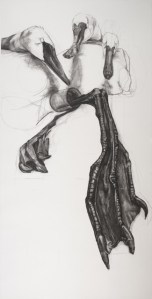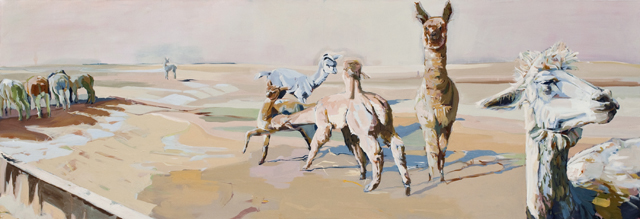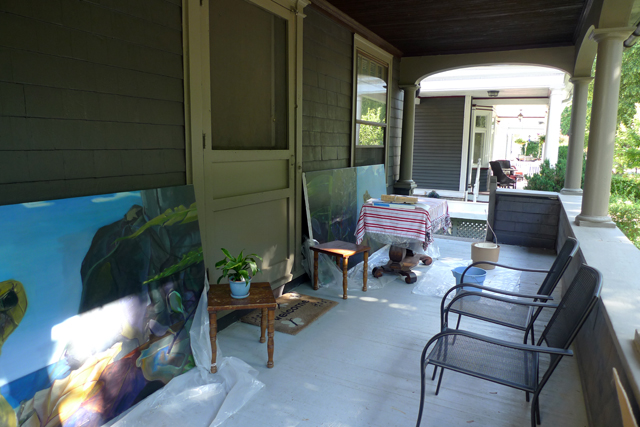Briefly describe the work you do.
I mainly identify as a painter, but my work ranges in materials from traditional and water-soluble oil paint, to ink, oil and chalk pastels, to graphite and charcoal. I generally work on paper or canvas. The content of my work focuses on social and individual states of being and the subjects of my work are often biological in nature. I feel I am hard pressed to find forms that are more structurally complex and visually stunning than natural living forms. I delight in studying their complexity and teasing out my associations with pedestrian life that I find in groupings of insects, livestock and plants.
Tell us a little about your background and how that influences you as an artist.
I spent a large part of my youth growing up outside on 9.75 acres of forest and hobby farm land in Vermont. I made a choice early on to not watch TV, which created a sizable gap in my knowledge of pop culture. This however did free up a large part of my time to explore and exist outside. Time to sit and listen, time to build, to reflect, to observe, to read, and to learn from and train the horses and house pets. I studied the results of my experimental vegetable garden. I watched as my carefully hypothesized ideas on best horticultural practice either grew or failed. I would eagerly take notes and collect seeds, often pumpkin, and try again. The main interest was in learning every intricacy of the plant or animal’s growth and life.Within my paintings these tracts of learning, observing and experimenting continue. The paintings and drawings become records of my attempts to truly see and think in depth about the structure and beauty of living organisms. Over time social and cultural observations have become more significant, permeating my mind and inevitably mixing with how I see natural forms. I welcome the complexity and see it as a way to reflect and center myself.
The concept of the “artist studio” has a broad range of meanings, especially in contemporary practice. The idea of the artist toiling away alone in a room may not necessarily reflect what many artists do from day to day anymore. Describe your studio practice and how it differs from (or is the same as) traditional notions of “being in the studio.”
The space I work in varies on whether or not I can bring my canvas and paints to the forms I am painting. For subject material I visit state fairs, herbariums, national parks, entomology museums, biology departments and my immediate back yard, with a sketch book and camera in hand. I have painted in veterinary medicine dissection labs, old football stadium studios and apartment parking lots. Most currently I spend as much time as possible painting outside for the pure necessity of excellent ventilation and light. ‘Being in the studio’ will change again as the seasons move into winter and I search for new subject matter and another place to paint.
What unique roles do you see yourself as the artist playing that you may not have envisioned yourself in when you first started making art?
When I first started making, I knew I could sustain my interest in art but I did not know how I could sustain myself in a career. It was not long, (through the help of some very important mentors,) before I was teaching at a college level and realizing my love for sharing the ability to make. Although teaching is not unique, it was at first a surprise to me, to find comfort standing in front of a group and presenting the next visual challenge to solve. The experience has been rewarding past what I could anticipate. Over the past six years, I have continued to learn from teaching each semester, and this trend endures at Rochester Institute of Technology in NY where I am currently a visiting assistant professor.
When do you find is the best time of day to make art? Do you have time set aside every day, every week or do you just work whenever you can?
I am a morning person but the best time to paint is all day. A four hour block of painting in the morning. An hour or two for a laid back lunch with a book. Then a four hour block of painting in the afternoon before dinner. I take breaks for a cup of tea as needed and I stretch and dance to keep my blood moving. During the summer I’ll spend as many days like this as possible with gallery/museum/library and exploration trips intermingled. On days when I can’t have a large block of time to paint, I try to make something for at least an hour. Despite how tired I am at the end of the day, if I can put music on and get myself in front of art materials for an hour, my mind is put at ease. All of the fullness of the day can empty out through making. I allow these single studio hours to be completely open with no expectations. Whim takes over and I play and experiment with whatever interests me at the moment. These single hours spent in the studio are incredibly important to my work, my process of thinking through ideas, and my enjoyment of making.
How has your work changed in the last five years? How is it the same?
Five years ago I was in grad school. I was experimenting with mark and process. I was asking myself how much of the stages of gesture and drawing should appear in the final stage of my paintings. There is something very raw and honest about the first dozen attempts of composition and form that lay underneath a finished painting. While these qualities remain part of my work, the paintings I’m working on now explore a more complete understanding of the objects under study. What has remained the same is my broad focus on natural subjects and social constructs.
Are there people such as family, friends, writers, philosophers or even pop icons that have had an impact on the work you do?
On a larger scope family, friends, peers and the varied books I pick up do have an impact on my approach to working habits and what I ultimately complete and show. Interactions with engaged thoughtful persons and texts are all part of the intellectual and emotionally supportive energy that helps enrich my thoughts and excites me to make. One specific example that has impacted my process is: Hellen and Scott Nearing’s writings in The Good Life. In part of this book they talk about organizing time with the goal of non-anxious, non-pressured or rushed work time. I have long debated and tested many different weekly self-imposed painting schedules, always questioning how much I can accomplish and whether it is enough. Their strategy is what I base my above described studio practice on and is the only strategy I’ve found that feels balanced and sustainable.
If you had an occupation outside of being an artist, what would that be and why?
If I had another occupation outside of my current work, I would likely find a way to stay close to the topics of botany or biology, studying specific wild or domesticated species. But I do have an occupation outside of being an artist, which is teaching. It is a big part of my current identity. What I do in the studio gives me energy and content to bring to the classroom, and what I learn from my experiences in the academic studios, I bring back to my work.
About
 Emily received her BFA from the State University of New York at Potsdam and her MFA degree in painting from Kansas State University. Emily is currently a Visiting Assistant Professor in the School of Art at Rochester Institute of Technology.Her personal work embraces the investigation of anatomical and structural forms of animals, insects and plants. Large panoramic paintings and small enclosed charcoal and pencil drawings make up the current boundaries of her process. What is at stake within her art is the development of individuals on a two dimensional surface. Some issues explored through this process of inspecting the figure are ideas of self-image, social indifference and social indulgence. Emily’s research leads to the study of cadavers in biology departments, insects in university entomology museums, and most recently biological matter in herbariums and the gardens of her immediate surroundings of Rochester NY.In the last three years Emily’s work has shown in juried and solo exhibitions in New York, Kansas, Arkansas, Iowa, Maryland, Oklahoma and Illinois. Most recently she participated in national juried exhibitions at The Fine Arts Center of Hot Springs Arkansas, the Maryland Federation of Art and the High Falls Museum in NY.
Emily received her BFA from the State University of New York at Potsdam and her MFA degree in painting from Kansas State University. Emily is currently a Visiting Assistant Professor in the School of Art at Rochester Institute of Technology.Her personal work embraces the investigation of anatomical and structural forms of animals, insects and plants. Large panoramic paintings and small enclosed charcoal and pencil drawings make up the current boundaries of her process. What is at stake within her art is the development of individuals on a two dimensional surface. Some issues explored through this process of inspecting the figure are ideas of self-image, social indifference and social indulgence. Emily’s research leads to the study of cadavers in biology departments, insects in university entomology museums, and most recently biological matter in herbariums and the gardens of her immediate surroundings of Rochester NY.In the last three years Emily’s work has shown in juried and solo exhibitions in New York, Kansas, Arkansas, Iowa, Maryland, Oklahoma and Illinois. Most recently she participated in national juried exhibitions at The Fine Arts Center of Hot Springs Arkansas, the Maryland Federation of Art and the High Falls Museum in NY.
All images copyright of the artist and used with their permission.




